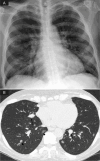Anaemia of Inflammation Preceding Dyspnoea, Dry Cough and Weight Loss in Primary Pulmonary Lymphoma
- PMID: 39790843
- PMCID: PMC11716307
- DOI: 10.12890/2024_004997
Anaemia of Inflammation Preceding Dyspnoea, Dry Cough and Weight Loss in Primary Pulmonary Lymphoma
Abstract
Introduction: There is little information in the literature on the early, sub-clinical stage and laboratory test results in patients with primary mucosa-associated lymphoid tissue (MALT) lymphoma of the lung, a rare disease.
Case description: In a 75-year-old man, an open lung biopsy-confirmed diagnosis of primary pulmonary lymphoma was preceded by almost six months of anaemia of inflammatory disease and monocytosis without any pulmonary symptoms. When he developed a dry cough, increasing dyspnoea and marked weight loss, these changes deepened and became associated with reactive thrombocytosis; markedly increased ferritin and C-reactive protein (positive acute-phase reactants), as well as reduced albumin and transferrin (negative acute-phase reactants). Globulins increased, due to an increase in the alpha1, alpha2 and gamma fractions, and mild hyponatraemia developed due to the syndrome of inappropriate antidiuretic hormone secretion (SIADH) secondary to the intrathoracic disease. All these changes were completely reversible following successful treatment and complete remission.
Conclusion: The previously unreported detailed laboratory features of early, sub-clinical and advanced primary pulmonary lymphoma are presented. When a potentially susceptible patient develops an unexplained anaemia of inflammatory disease, primary pulmonary lymphoma should be added to the differential diagnosis.
Learning points: B-cell pulmonary lymphoma without extra-pulmonary disease (primary pulmonary lymphoma) remains a rare entity, often arising from mucosa-associated lymphoid tissue, presenting with non-specific symptoms (cough, dyspnoea) and imaging (nodules <5 cm or areas of consolidation on CT), and diagnosed by an adequate biopsy.Our patient's course demonstrates early, pre-clinical changes: anaemia of inflammation and monocytosis, which became more severe as symptoms developed and imaging abnormalities progressed, and was associated with marked acute-phase response (for example, substantially increased ferritin levels), increased globulins and hyponatraemia due to the syndrome of inappropriate antidiuretic hormone secretion.In patients with unexplained anaemia of inflammatory disease, occult pulmonary lymphoma should be considered in the differential diagnosis.
Keywords: Primary pulmonary lymphoma diagnosis; anaemia of inflammation; hyperferritinaemia; monocytosis; primary pulmonary lymphoma.
© EFIM 2024.
Conflict of interest statement
Conflicts of Interests: The Authors declare that there are no competing interests.
Figures


References
-
- Cadranel J, Wislez M, Antoine M. Primary pulmonary lymphoma. Eur Respir J. 2002;20:750–762. - PubMed
-
- Koss MN. Malignant and benign lymphoid lesions of the lung. Ann Diagn Pathol. 2004;8:167–187. - PubMed
-
- Sirajuddin A, Raparia K, Lewis VA, Franks TJ, Dhand S, Galvin JR, et al. Primary pulmonary lymphoid lesions: radiologic and pathologic findings. Radiographics. 2016;36:53–70. - PubMed
LinkOut - more resources
Full Text Sources
Research Materials
